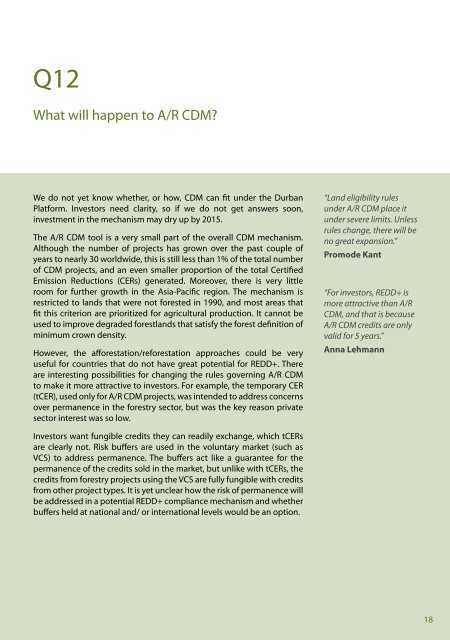Forests and climate change after Durban - RECOFTC
Forests and climate change after Durban - RECOFTC
Forests and climate change after Durban - RECOFTC
Create successful ePaper yourself
Turn your PDF publications into a flip-book with our unique Google optimized e-Paper software.
Q12What will happen to A/R CDM?We do not yet know whether, or how, CDM can fit under the <strong>Durban</strong>Platform. Investors need clarity, so if we do not get answers soon,investment in the mechanism may dry up by 2015.The A/R CDM tool is a very small part of the overall CDM mechanism.Although the number of projects has grown over the past couple ofyears to nearly 30 worldwide, this is still less than 1% of the total numberof CDM projects, <strong>and</strong> an even smaller proportion of the total CertifiedEmission Reductions (CERs) generated. Moreover, there is very littleroom for further growth in the Asia-Pacific region. The mechanism isrestricted to l<strong>and</strong>s that were not forested in 1990, <strong>and</strong> most areas thatfit this criterion are prioritized for agricultural production. It cannot beused to improve degraded forestl<strong>and</strong>s that satisfy the forest definition ofminimum crown density.However, the afforestation/reforestation approaches could be veryuseful for countries that do not have great potential for REDD+. Thereare interesting possibilities for changing the rules governing A/R CDMto make it more attractive to investors. For example, the temporary CER(tCER), used only for A/R CDM projects, was intended to address concernsover permanence in the forestry sector, but was the key reason privatesector interest was so low.“L<strong>and</strong> eligibility rulesunder A/R CDM place itunder severe limits. Unlessrules <strong>change</strong>, there will beno great expansion.”Promode Kant“For investors, REDD+ ismore attractive than A/RCDM, <strong>and</strong> that is becauseA/R CDM credits are onlyvalid for 5 years.”Anna LehmannInvestors want fungible credits they can readily ex<strong>change</strong>, which tCERsare clearly not. Risk buffers are used in the voluntary market (such asVCS) to address permanence. The buffers act like a guarantee for thepermanence of the credits sold in the market, but unlike with tCERs, thecredits from forestry projects using the VCS are fully fungible with creditsfrom other project types. It is yet unclear how the risk of permanence willbe addressed in a potential REDD+ compliance mechanism <strong>and</strong> whetherbuffers held at national <strong>and</strong>/ or international levels would be an option.18
















